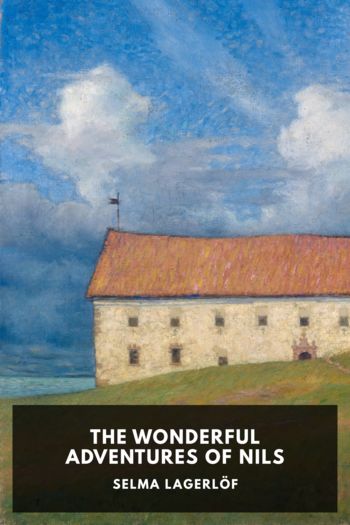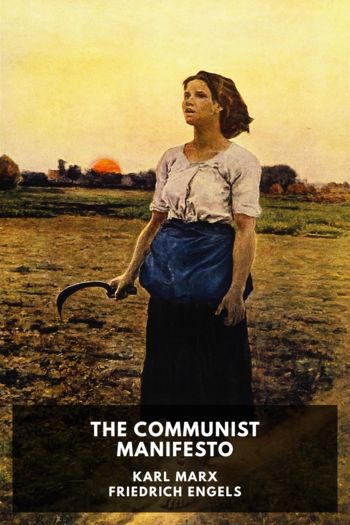The Wonderful Adventures of Nils by Selma Lagerlöf (i can read book club TXT) 📕

- Author: Selma Lagerlöf
Book online «The Wonderful Adventures of Nils by Selma Lagerlöf (i can read book club TXT) 📕». Author Selma Lagerlöf
“But the very lowest step is the best of all. It is covered with good rich soil; and, where it lies and bathes in the sea, it hasn’t the slightest feeling of the Småland chill. Beeches and chestnut and walnut trees thrive down here; and they grow so big that they tower above the church-roofs. Here lie also the largest grainfields; but the people have not only timber and farming to live upon, but they are also occupied with fishing and trading and seafaring. For this reason you will find the most costly residences and the prettiest churches here; and the parishes have developed into villages and cities.
“But this is not all that is said of the three steps. For one must realise that when it rains on the roof of the big Småland house, or when the snow melts up there, the water has to go somewhere; and then, naturally, a lot of it is spilled over the big stairway. In the beginning it probably oozed over the whole stairway, big as it was; then cracks appeared in it, and, gradually, the water has accustomed itself to flow alongside of it, in well dug out grooves. And water is water, whatever one does with it. It never has any rest. In one place it cuts and files away, and in another it adds to. Those grooves it has dug into vales, and the walls of the vales it has decked with soil; and bushes and trees and vines have clung to them ever since—so thick, and in such profusion, that they almost hide the stream of water that winds its way down there in the deep. But when the streams come to the landings between the steps, they throw themselves headlong over them; this is why the water comes with such a seething rush, that it gathers strength with which to move mill-wheels and machinery—these, too, have sprung up by every waterfall.
“But this does not tell all that is said of the land with the three steps. It must also be told that up in the big house in Småland there lived once upon a time a giant, who had grown very old. And it fatigued him in his extreme age, to be forced to walk down that long stairway in order to catch salmon from the sea. To him it seemed much more suitable that the salmon should come up to him, where he lived.
“Therefore, he went up on the roof of his great house; and there he stood and threw stones down into the East sea. He threw them with such force that they flew over the whole of Blekinge and dropped into the sea. And when the stones came down, the salmon got so scared that they came up from the sea and fled toward the Blekinge streams; ran through the rapids; flung themselves with high leaps over the waterfalls, and stopped.
“How true this is, one can see by the number of islands and points that lie along the coast of Blekinge, and which are nothing in the world but the big stones that the giant threw.
“One can also tell because the salmon always go up in the Blekinge streams and work their way up through rapids and still water, all the way to Småland.
“That giant is worthy of great thanks and much honour from the Blekinge people; for salmon in the streams, and stone-cutting on the island—that means work which gives food to many of them even to this day.”
By Ronneby RiverFriday, April first.
Neither the wild geese nor Smirre Fox had believed that they should ever run across each other after they had left Skåne. But now it turned out so that the wild geese happened to take the route over Blekinge and thither Smirre Fox had also gone.
So far he had kept himself in the northern parts of the province; and since he had not as yet seen any manor parks, or hunting grounds filled with game and dainty young deer, he was more disgruntled than he could say.
One afternoon, when Smirre tramped around in the desolate forest district of Mellanbygden, not far from Ronneby River, he saw a flock of wild geese fly through the air. Instantly he observed that one of the geese was white and then he knew, of course, with whom he had to deal.
Smirre began immediately to hunt the geese—just as much for the pleasure of getting a good square meal, as for the desire to be avenged for all the humiliation that they had heaped upon him. He saw that they flew eastward until they came to Ronneby River. Then they changed their course, and followed the river toward the south. He understood that they intended to seek a sleeping-place along the riverbanks, and he thought that he should be able to get hold of a pair of them without much trouble. But when Smirre finally discovered the place where the wild geese had taken refuge, he observed they had chosen such a well-protected spot, that he couldn’t get near.
Ronneby River isn’t any big or important body of water; nevertheless, it is just as much talked of, for the sake of its pretty shores. At several points it forces its way forward between steep mountain-walls that stand upright out of the water, and are entirely overgrown with honeysuckle and bird-cherry, mountain-ash and osier; and there isn’t much that can be more delightful than to row out on the little dark river





Comments (0)